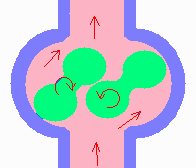Lobe Pumps
In principle the lobe pump is similar to the external gear pump; liquid flows into the region created as the counter-rotating lobes unmesh. Displacement volumes are formed between the surfaces of each lobe and the casing, and the liquid is displaced by meshing of the lobes. Relatively large displacement volumes enable large solids (nonabrasive) to be handled. They also tend to keep liquid velocities and shear low,
making the pump type suitable for high viscosity, shear-sensitive liquids.
Two lobe pump

Three lobe pump

The choice of two or three lobe rotors depends upon solids size, liquid viscosity, and tolerance of flow pulsation. Two lobe handles larger solids and high viscosity but pulsates more.
Larger lobe pumps cost 4-5 times a centrifugal pump of equal flow and head.
